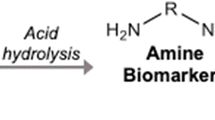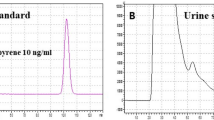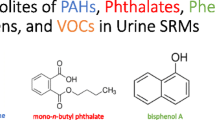Abstract
Objectives: The objectives of this study were to determine the levels of 2,4-toluenediamine, 2,6-toluenediamine, 1,5-naphthtalenediamine and 4,4′-methylenediphenyldianiline in hydrolyzed urine and plasma for occupationally unexposed workers and to calculate upper reference limits (URLs). These analytes are biomarkers of exposure to 2,4-toluene diisocyanate and 2,6-toluene diisocyanate (2,4-TDI and 2,6-TDI), 1,5-naphtalene diisocyanate (NDI) and 4,4′-methylenediphenyl diisocyanate (MDI), respectively. Methods: The biomarker levels were determined in urinary and plasma samples obtained from 121 occupationally unexposed workers. Based on these biomarkers levels and the biomarker levels in an occupationally exposed group of workers, URLs were calculated. The method used for these calculations was based on the receiver operator characteristic (ROC) curve method technique, and the URLs were set at the optimum of sum of sensitivity and specificity. Results: The URLs for the different diisocyanates were calculated to be in the range of 0.1–0.5 μg/L. Occupationally unexposed workers had detectable biomarker levels of the diisocyanates investigated. Especially abundant was the biomarkers of MDI which were found in 97% of both urinary and plasma samples. For the other biomarkers, 0–15% of the unexposed workers had detectable levels. The detected levels were mostly close to the limit of detection (LOD), but urinary levels of biomarkers of MDI up to 60 times the LOD were found. The sensitivities and specificities for classification of the workers as occupationally exposed or not, were in the range of 88–100% and 97–100%, respectively. Conclusions: The URLs were calculated that may be applicable when screening for occupational exposure. A worker with a biomarker level above the URL will be classified as occupationally exposed. Biomarkers of aromatic diisocyanates, especially biomarkers of MDI, were present among occupationally unexposed workers, but the source and nature of the exposure is unknown.

Similar content being viewed by others
References
Aitio A (1994) Reference limits in occupational toxicology. Clin Chem 40:1385–1386
Alessio L (1992) Reference values for the study of low doses. Sci Total Environ 120:1–6
Altman DG (1991) Diagnostic tests. In: Practical statistics for medical research. Chapman & Hall, London, pp414–419
Apostoli P (1999) Application of reference values in occupational health. Int Arch Occup Environ Health 72:191–194
Baur X, Marek W, Ammon J, Czuppon AB, Marczynski B, Raulf-Heimsoth M, Roemmelt H, Fruhmann G (1994) Respiratory and other hazards of isocyanates. Int Arch Occup Environ Health 66:141–152
Brorson T, Skarping G, Sangö C (1991) Biological monitoring of isocyanates and related amines—part IV: 2,4- and 2,6-toluenediamine in hydrolyzed plasma and urine after test-chamber exposure of humans to 2,4- and 2,6-toluene diisocyanate. Int Arch Occup Environ Health 63:253–259
Brunmark P, Bruze M, Skerfving S, Skarping G (1995) Biomonitoring of 4,4′-methylene dianiline by measurement in hydrolysed urine and plasma after epicutaneous exposure in humans. Int Arch Occup Environ Health 67:95–100
Dalene M, Jakobsson K, Rannug A, Skarping G, Hagmar L (1996) MDA in plasma as a biomarker of exposure to pyrolysed MDI-based polyurethane: correlations with estimated cumulative dose and genotype for N-acetylation. Int Arch Occup Environ Health 68:165–169
Damant AP, Jickells SM, Castle L (1995) Liquid chromatographic determination of residual isocyanate monomers in plastics intended for food contact use. J AOAC Int 78:711–719
Ewers U, Krause C, Schulz C, Wilhelm M (1999) Reference values and human biological monitoring values for environmental toxins. Int Arch Occup Environ Health 72:255–260
Health and Safety Executive (1999) Organic isocyanates in air, MDHS 25/3. Sudbury: Health and Safety Laboratory
IARC (1986) Some chemicals used in plastics and elastomers. IARC monographs on the evaluation of the carcinogenic risk of chemicals to humans. Lyon, France: Int Agency Res Cancer 39:347–368
Krone CA, Ely JTA, Klingner T, Rando RJ (2003) Isocyanates in flexible polyurethane foams. Bull Environ Contamin Toxicol 70:328–335
Kääriä K, Hirvonen A, Norppa H, Piirilä P, Vainio H, Rosenberg C (2001) Exposure to 2,4- and 2,6-toluene diisocyanate (TDI) during production of flexible foam: determination of airborne TDI and urinary 2,4- and 2,6-toluenediamine (TDA). Analyst 126:1025–1031
Lind P, Dalene M, Tinnerberg H, Skarping G (1997) Biomarkers in hydrolysed urine, plasma and erythrocytes among workers exposed to thermal degradation products from toluene diisocyanate foam. Analyst 122:51–56
Liu Q, Wisnewski AV (2003) Recent developments in diisocyanate asthma. Ann Allergy Asthma Immunol 90:35–41
Lushniak BD, Reh CM, Bernstein DI, Gallagher JS (1998) Indirect assessment of methylenediphenyl diisocyanate (MDI) exposure by evaluation of specific humoral responses to MDI conjugated to human serum albumin. Am J Ind Med 33:471–477
Morton J, Mason HJ, Ritchie KA, White M (2004) Comparison of hair, nails and urine for biological monitoring of low level inorganic mercury exposure in dental workers. Biomarkers 9:47–55
Myers JE, Thompson ML, Naik I, Theodorou P, Esswein E, Tassell H, Daya A, Renton K, Spies A, Paicker J, Young T, Jeebhay M, Ramushu S, London L, Rees DJ (2003) The utility of biological monitoring for manganese in ferroalloy smelter workers in South Africa. Neurotoxicology 24:875–883
Sabbioni G, Hartley R, Schneider S (2001) Synthesis of adducts with amino acids as potential dosimeters for the biomonitoring of humans exposed to toluenediisocyanate. Chem Res Toxicol 14:1573–1583
Sennbro CJ, Lindh CH, Tinnerberg H, Gustavsson C, Littorin M, Welinder H, Jonsson BAG (2003) Development, validation and characterization of an analytical method for quantification of hydrolysable urinary metabolites and plasma protein adducts of 2,4- and 2,6-toluene diisocyanate, 1,5-naphthalene diisocyanate and 4,4′-methylenediphenyl diisocyanate. Biomarkers 8:204–217
Sennbro CJ, Lindh CH, Tinnerberg H, Welinder H, Littorin M, Jönsson BAG (2004a) Biological monitoring of exposure to toluene diisocyanate. Scand J Work Environ Health 30:371–378
Sennbro CJ, Lindh CH, Östin A, Welinder, Jönsson BAG, Tinnerberg H (2004b) A survey of airborne isocyanate exposure in thirteen Swedish polyurethane industries. Ann Occup Hyg 48:405–414
Sepai O, Henschler D, Sabbioni G (1995) Albumin adducts, hemoglobin adducts and urinary metabolites in workers exposed to 4,4’-methylenediphenyl diisocyanate. Carcinogenesis 16:2583–2587
Solberg HE (1987a) Approved recommendations (1986) on the theory of reference values Part 1. The concept of reference values. Clin Chim Acta 165:111–118
Solberg HE (1987b) Approved recommendations (1987) on the theory of reference values Part 5. Statistical treatment of collected reference values. Determination of reference limits. Clin Chim Acta 170:S13–S32
Vandenplas O, Malo J-L, Saetta M, Mapp CE, Fabbri LM (1993) Occupational asthma and extrinsic alveolitis due to isocyanates: current status and perspectives. Br J Ind Med 50:213–228
Wirts M, Grunwald D, Schulze D, Uhde E, Salthammer T (2003) Time course of isocyanate emission from curing polyurethane adhesives. Atmos Environ 37:5467–5475
Acknowledgement
Financial support for this work was obtained from AFA Foundation, Sweden, from the Swedish Council for Work Life and Social Research and from the Swedish Research Council. The authors also thank Prof. Ulf Strömberg at the Department of Occupational and Environmental Medicine, Lund, Sweden, for statistical consultations, Dr. Christian Lindh, Mr. Christian Mattsson, Ms. Birgitta Björk, Ms. Cecilia Gustavsson, Ms. Inger Bensryd and Ms. Kerstin Diab-Kronholm at the Department of Occupational and Environmental Medicine, Lund, Sweden, for skilful technical and medical assistance, and all the workers in the study for invaluable participation.
Author information
Authors and Affiliations
Corresponding author
Rights and permissions
About this article
Cite this article
Sennbro, C.J., Littorin, M., Tinnerberg, H. et al. Upper reference limits for biomarkers of exposure to aromatic diisocyanates. Int Arch Occup Environ Health 78, 541–546 (2005). https://doi.org/10.1007/s00420-005-0619-5
Received:
Accepted:
Published:
Issue Date:
DOI: https://doi.org/10.1007/s00420-005-0619-5




